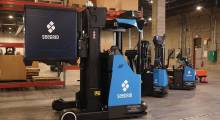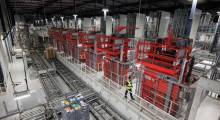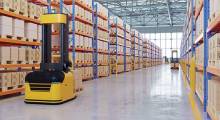Title: President
Role: A3 Motion Control and Motors Technology Strategy Board
Location: Savage, Minn.
Experience: 32 years in the robotics and motion control industry
Modern: There’s nothing hotter in DCs and warehouses right now than automation. And within automation, robots are the headliners. From your new position on the Association for Advancing Automation (A3) Motion Control and Motors Technology Strategy Board, what do you see as key issues going forward?
Barker: There’s no question that robotics is in the limelight more than motion control. But let’s face it, you can’t get a robot to do anything without motion control technology. Nothing moves without motion control. It’s critical to the future of automation. That’s why I’m so excited to be starting my three years on the A3 Motion Control and Motors Technology Strategy Board.
Technology developments in motion control from integrated safety, to cameras, to machine learning will have a direct impact on advances in Industry 4.0 technologies such as robots that are remaking the supply chain all the way down to lot sizes of one. And with new developments in mechatronics technology for highly dynamic materials handling, motion control is still a very exciting space to be in. As part of the board, I hope to be able to help A3 advocate for the benefits of automation, promote its role and share best practices.
Modern: Will this technology be a game changer for industry?
Barker: There’s no question about that. We’re in a stage of development now that will decouple specific steps and processes in the value chain. These changes will allow us to re-imagine everything from manufacturing to assembly to final packaging to distribution. In many ways, facilities are still set up much like the assembly lines Henry Ford used more than a century ago. With the guidance of modern motion control technologies, automation is early on its path to being much more adaptive and flexible.
We’re really on the edge of developing automation that adapts to mass customization. That’s a whole lot more productive than the way we do it now, where the product is limited by the process and the automation. There will soon be a decoupling of linear thinking for all automation processes. I expect to see many key advances here in the next three years.
Modern: Can you give us an idea of what some of those advances might be?
Barker: Sure. The heart of motion control is capturing information and then processing it to produce a highly controlled response from the motor. Those motors move robots and other types of automated equipment. Our ability to capture, process and integrate information is unprecedented, and we’re just getting started. That’s what enables advances in complex motion applications like humanoid robots, adaptive manufacturing, and automated mobile robots to become a reality.
Modern: But all of that is what’s happening at companies such as Beckhoff. What can the A3 Technology Strategy Board do
to help?
Barker: The clear mission at A3 is why I’m so pleased to be part of the organization. A3 is the advocate for the benefits of automating. We’re at a really important time to automate in this country. For me personally, it’s fun and energizing to help solve some of the big challenges like re-shoring, the skills gap, supply chain optimization and labor shortages. And the A3 Board does just that.
Article topics










